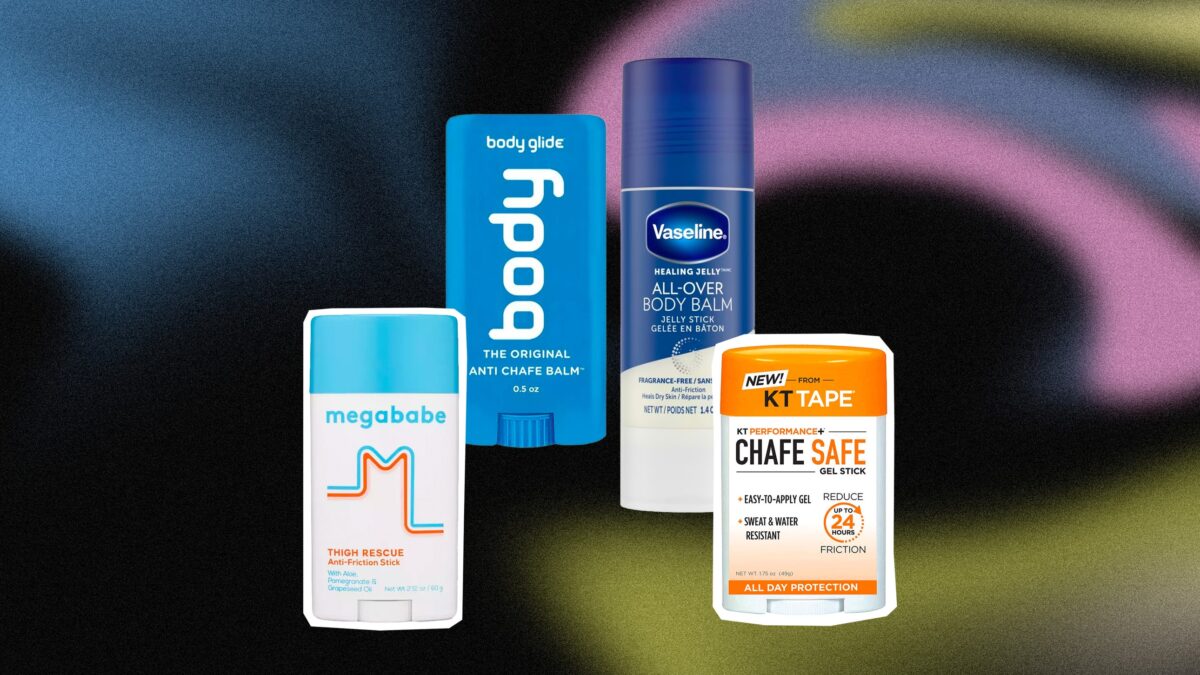
Few things can stop you in your tracks quite like the feeling of raw skin during hot weather, getting fierer with every passing minute. That’s where chafing creams and sticks come in. Chafing, sometimes endearingly referred to as chub rub, doesn’t just happen to runners—or those without the supermodel-like thigh gap. Chafing can happen pretty much anywhere skin rubs together—like where the arm meets the torso, or underneath the breasts.
Best Anti-Chafing Creams and Sticks 2023:
Chafing is caused by the repeated rubbing of the skin, either by other sites of skin or by ill-fitting clothing, says Dustin Portela, MD, a board-certified dermatologist in Idaho. Excess moisture—especially sweat—is the big culprit too. “The chronic rubbing breaks down and irritates the skin leading to pain, blisters, and sometimes bleeding.” Ouch!
So what can you do to ease the burning and itchy feeling? Though your first thought may be to reach for cornstarch or some kind of powder—you know, to dry the skin—lotions, creams, salves, and ointments (sometimes called chamois cream by those in the know) are superior, since they allow the skin to glide rather than stick, says Claire Wolinsky, MD, a board-certified dermatologist in New York City. Look for chafing creams and sticks that include ingredients like petroleum jelly (petrolatum), glycerin, dimethicone, and zinc oxide—they act as skin protectants and reduce friction, she says. (Likewise, products that contain emollients and skin-soothing natural ingredients such as shea butter, coconut oil, aloe vera, and vitamin E can help ease discomfort.)
Types of chafing creams
There are a variety of products on the market and they come in many forms. So what’s the difference, and how do you use them? Elizabeth Kaplanis, founder and head coach of RTA Triathlon in New Jersey, breaks it all down:
- Cream: Chafing cream, or chamois cream, is a thick white cream applied either directly onto the body—in the uppermost area of inner thighs to prevent irritated skin—or to the inside of your chamois pad (basically the padded crotch section of cycling shorts) or the seams of your running shorts. The key here is to be liberal, applying a thick layer to the front and the back of your clothing or skin to prevent thigh chafing. Don’t rub it in, either—you want it to serve as a protective barrier between your skin and whatever might rub against it.
- Sticks: A chafing stick looks like a stick of deodorant and goes on somewhat clear. You can use them in all of the same places as cream, but they’re a bit less conspicuous—perfect for applying underneath breasts or to spots around your armpit if you’re wearing a tank top. They’re easy to apply and nice and portable too. “My sports bra line tends to accumulate a lot of sweat—especially under my chest,” says Kaplanis. “Sticks are great here, but when the sweat burn gets really bad, I prefer to use cream as the ultimate defender.”
- Aerosols: Aerosol lubricants are super easy to apply—you simply spray where you need. Aerosol lube is also “friend-friendly,” says Kaplanis. “No one wants to share their body glide, but spray lube can be tossed around between teammates since your body doesn’t actually touch the nozzle.”
How do you prevent chafing?
Depending on where chafing occurs, you may also be able to ease the pain—and prevent future skin irritation—through the use of technical sports undergarments, says Portela. Sometimes other physical barriers, like bandages, can help too—that’s why runners sometimes use Band-Aids as nipple covers.
A few other tips, especially for athletes? “Don’t sit in sweaty clothes,” says Kaplanis. Wet, sweaty skin is more prone to chafing. Post-workout, shower as soon as you can. And don’t forget to hydrate. “The more hydrated you are, the more diluted your sweat will be,” says Kaplanis. “Up your water intake and be sure to replace those electrolytes that you’re losing.”
To save you time shopping and help you narrow in on anti-chafing cream that really works, we asked dermatologists, professional triathletes, and our expert editorial team to weigh in. Shop 7 tested and reviewed options—scented, unscented, and fragrance-free—that actually work for all skin types, below.













